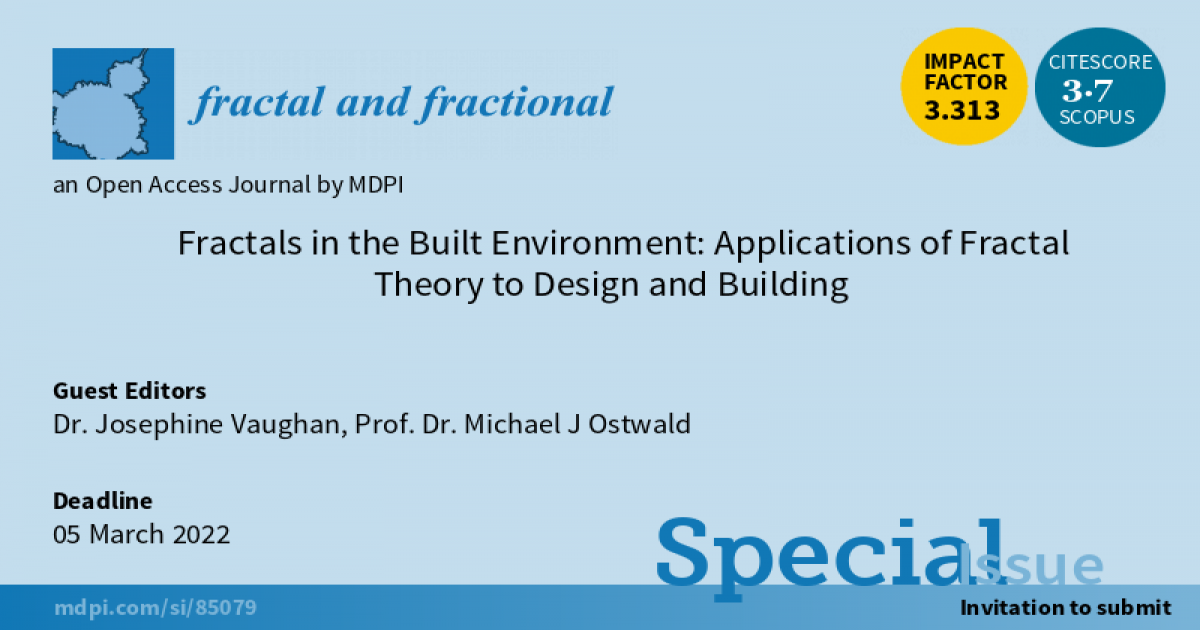Fractals in the Built Environment: Applications of Fractal Theory to Design and Building
A special issue of Fractal and Fractional (ISSN 2504-3110). This special issue belongs to the section "Geometry".
Deadline for manuscript submissions: closed (5 March 2022) | Viewed by 20084

Special Issue Editors
Interests: building materials; construction Managament; fractals; sustainable architecture
Interests: architecture; design; mathematics; computing
Special Issues, Collections and Topics in MDPI journals
Special Issue Information
Dear Colleagues,
Since Benoit Mandelbrot first used architectural examples to explain fractals, fractal theory has contributed to the design, development, construction, analysis, and understanding of the built environment. This Special Issue brings together research and analytical applications of fractal theory in buildings, construction, design, engineering, and architecture (recent, historical, or ancient), as well as fractals in the broader urban context, including urban morphology, planning, parks, landscapes, and green space.
This issue invites papers that use fractal dimensions to measure and understand the built environment along with applications of research into fractal geometry, for example, fractally generated design, or other applications or combinations of fractal theory. To be accepted to this issue, however, papers must state in the methodology (or other appropriate place) which application of fractal theory is used and be clear about perspective, purpose, precedents, and limitations of your approach.
Should your research explore fractal geometry and the built environment, please include a description of your focus (for example, in phenomena, structure, form, ornament, or inspiration). Should your research apply fractal dimensions to the built environment, please include details on what you are measuring, estimating, and/or analyzing, including your calculation method and details on the subject of your calculations, preferably including at least one example image and appropriate references.
Dr. Josephine Vaughan
Prof. Dr. Michael J Ostwald
Guest Editors
Manuscript Submission Information
Manuscripts should be submitted online at www.mdpi.com by registering and logging in to this website. Once you are registered, click here to go to the submission form. Manuscripts can be submitted until the deadline. All submissions that pass pre-check are peer-reviewed. Accepted papers will be published continuously in the journal (as soon as accepted) and will be listed together on the special issue website. Research articles, review articles as well as short communications are invited. For planned papers, a title and short abstract (about 100 words) can be sent to the Editorial Office for announcement on this website.
Submitted manuscripts should not have been published previously, nor be under consideration for publication elsewhere (except conference proceedings papers). All manuscripts are thoroughly refereed through a single-blind peer-review process. A guide for authors and other relevant information for submission of manuscripts is available on the Instructions for Authors page. Fractal and Fractional is an international peer-reviewed open access monthly journal published by MDPI.
Please visit the Instructions for Authors page before submitting a manuscript. The Article Processing Charge (APC) for publication in this open access journal is 2700 CHF (Swiss Francs). Submitted papers should be well formatted and use good English. Authors may use MDPI's English editing service prior to publication or during author revisions.
Keywords
- Fractal dimension
- Fractal geometry
- Built environment
- Fractal theory
- Architecture
- Design
- Building
- Urban landscape
Benefits of Publishing in a Special Issue
- Ease of navigation: Grouping papers by topic helps scholars navigate broad scope journals more efficiently.
- Greater discoverability: Special Issues support the reach and impact of scientific research. Articles in Special Issues are more discoverable and cited more frequently.
- Expansion of research network: Special Issues facilitate connections among authors, fostering scientific collaborations.
- External promotion: Articles in Special Issues are often promoted through the journal's social media, increasing their visibility.
- e-Book format: Special Issues with more than 10 articles can be published as dedicated e-books, ensuring wide and rapid dissemination.
Further information on MDPI's Special Issue policies can be found here.






